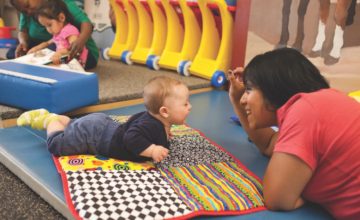Many young children proudly pull the straps of a brand-new backpack over their shoulders and head off to an early education setting sometime between ages two and four. But one of the most important things a child takes with her on that first morning isn’t visible at all: her home languages.
Partnering with your child’s teachers can help to ensure that your child’s language skills continue to grow, along with her connections to family, community and culture. Here are some tips:
Approach the school and ask to meet with teachers before your child’s first day.
Meeting before your child starts the program gives you a chance to explain how your child communicates. Every dual language learner is different—some may speak (or understand) more of one language than another. Explaining how your child uses language, and the languages he/she is exposed to at home, gives teachers important information about how to meet her needs. This information also helps teachers put a child’s behavior in context—for example, a child may not put his coat on when asked because he didn’t understand the instructions or is not yet confident enough in English to ask for help.
Provide teachers with a list of common words your child uses in her home language.
Create a list of words (along with a simple guide to pronouncing them) that your child uses frequently to have her needs met. For example, your list might include words for: mommy, daddy, breakfast/lunch, hungry, water/thirsty, hurt/sick/tired, diaper/toilet, etc. You might even offer to record yourself pronouncing each word and text/email these short videos to the teacher as a reference.
If your child is entering the setting with almost no English, remind teachers that he may need one-on-one support to participate in daily routines. Simple picture cards, labeled in both English and the home language, can also help with communication until his vocabulary grows.
Finally, ask that teachers avoid using only the home language for limit-setting/discipline. When a child hears her home language only for discipline purposes in the school setting, it sends a negative message. On the other hand, teachers can praise a child’s communication efforts, no matter which language he is using.
Suggest ways you can provide support.
Given how diverse most early childhood programs are, it’s impossible for teachers to learn every language spoken by every student. This creates an opportunity for parents to contribute rich home language experiences. For example, could you make a video of yourself reading a story that teachers could play for children? Or do the same for traditional songs and rhymes? During special times of the year, offer to join the class and share a tradition from your home culture. Most early education settings have labels on many items in their classroom as a strategy to build children’s print awareness. You might offer to create labels in your child’s home language. Be sure to print these words in a different color than the English labels—over time, your child will learn that “her” languages are both the blue and the green words. Finally, you can offer to share some of your child’s books with the class, or send in empty food boxes or dress-up clothes from your home culture for pretend play.
Set up outside-of-school play opportunities.
It can be challenging to build friendships when you don’t share a language. Consider scheduling peer play opportunities at home to nurture children’s growing bonds. Ask your child’s teacher which child(ren) he seems to play with most, and start there. Offer the children activities that don’t need a lot of language but that encourage shared play—think about musical instruments, a homemade obstacle course, sensory (sand/water) play, or a shared cooking or art activity.
Make your home a nurturing language environment.
Research shows that children’s home language use begins to drop as they enter formal school settings where English is the primary language. To become truly bilingual, children need rich, consistent exposure to each language. If your child’s setting mainly uses English, you may choose to emphasize your home language in order to nurture these skills. Research shows that children who continue to learn and use their home language actually do better learning English because they have the advantage of the rich cultural vocabulary and knowledge of their families.
Wrapping Up
Our roots are wrapped up in language—the words that were sung to us, the stories told to us, the jokes shared with us. Offering children the opportunity to develop deeper, stronger language roots is truly a gift, and one that research has found has benefits across the lifespan. When partnering with your child’s teachers on home language issues, collaboration is important. By working together, you can help to build the rich language environment your child needs to develop strong language skills (times two!).




